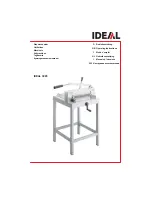
-30-
below or on the same level as the surface of the
indexable cutting insert (see Fig. 5).
4.8
Laying the connection cable
Danger
While working, pay attention to how
the connecting cable is laid. A
poorly laid connecting cable can
impair safety functions and working
functions and come into contact
with the tool.
How to lay the cable is shown in Fig. 12 by way of
example.
Lead the connecting cable away from the machine in
the direction of the cable sleeve. Always keep the
connecting cable as far away as possible from the
working tool. For support, use the Velcro fastener on
the extraction connection.
5
Operation
5.1
Initial operation
Personnel entrusted to work with the machine must
be made aware of the operating instructions, calling
particular attention to the chapter "Safety
instructions".
5.2
Switching on and off
•
Switching on:
Press the switch-on lock 7 (Fig.
1) forward to unlock it. Then, with the switch-on
lock depressed, press shift lever 8.
As this is a switch without locking device, the
machine will only run for as long as this shift lever is
pressed.
The built-in electronic system provides for jerk-free
acceleration when the machine is switched on and
readjusts the speed to the fixed setting.
In addition, the electronic system switches off the
motor in case of overload, i.e. the tool will stop.
Release shift lever 8. Then switch the machine on
again and continue milling at a reduced feed speed.
•
Switching off:
To switch off, release the shift
lever 8 (Fig 1). The built-in automatic brake
limits the coasting time of the tool to approx. 3 s.
The switch-on lock takes effect again
automatically and secures the cross-cut milling
system against accidental switch-on.
5.3
Milling depth adjustment
The milling depth is continuously variable between 0
and 50 mm.
Follow the procedure below:
•
Press the push-button 11 (Fig. 2) and adjust the
milling depth with the plunge lever 6.
•
The milling depth can be read off the scale on
the cover. The area of plunge lever 6 with the
red background serves as indicator.
5.4
Milling depth locking device / repeater depth
stop
The milling depth locking device is used to lock the
set milling depth. After defining the milling depth
once, it can easily be set without measuring again.
Follow the procedure below:
•
Set the machine to the desired milling depth.
•
Open the clamping lever 14 (Fig. 2) and set the
stop bar 16 downwards to the limit stop.
•
Retighten the fastening lever 14 (Fig. 2).
At low milling depths, you must
position the repeater depth stop
adapter 52 (Fig. 2) underneath the
stop bar 16.
5.5
Setting for working at a tilt
The milling unit can be set to any angle between 0°
and 45° for both tilted milling and notch milling work.
•
In order to incline it, bring the machine into
home position and support it such that it is
possible to tilt the milling unit.
•
Unfasten the clamping lever 10 (Fig. 2).
•
Adjust the angle according to the scale on the
swivel segment.
•
Retighten the clamping lever 10.
We provide a calculation tool for
calculating the milling depth. You
can access this tool via the QR
code on the machine or the website
specified on the label.
















































